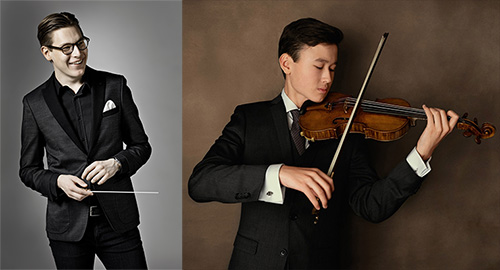by Daniel Hathaway

Mäkelä, 23, led a crisp, animated account of Zoltán Kodály’s Dances of Galanta to open the evening, stylishly shaping transitions and expressive nuances. Principal clarinet Afendi Yusuf dispatched numerous solos with radiant, colorful tone, and hornist Michael Mahew made golden moments of his time in the spotlight. Written to celebrate the 80th birthday of the Budapest Philharmonic Society, it’s difficult to imagine that Kodály’s dances have their origin in the tradition of Verbunkos — recruiting music designed to entice often illiterate young men to enter the military with promises of glory and fancy uniforms. Or perhaps not so difficult after all, considering how enticing they can be in performances like this one.
At 18, even younger than his colleague on the podium, Lozakovich brought delicacy and mature insights to his solo role in Max Bruch’s early Violin Concerto No. 1, the work that almost single-handedly has kept the composer’s name alive ever since he completed the first version of the work in 1866 at the age of 28.
The concerto begins with a free-spirited prelude featuring solo cadenzas that gave Lozakovich plenty of opportunity to share his lyrical gifts with the audience. Those opportunities continue with a seamless transition into the mellifluous slow movement, finally giving way to some violinistic calisthenics in the finale — its theme instantly recognizable even to those who don’t know where it comes from.
Under the sweltering conditions, Lozakovich would deserve great credit merely for holding on to his instrument, but he accomplished much more than that. He sympathetically shaped Bruch’s solo lines, creating moments of exquisite beauty, and addressed technical passages with easy virtuosity. With age and experience, he’d surely tailor his playing to the exigencies of an outdoor venue where sheer projection often needs to trump delicacy.
The audience clearly adored Lozakovich, who initially seemed shy about offering an encore, but after several callbacks, gave them an expressive performance of the Adagio from J.S. Bach’s Solo Violin Sonata No. 1.
Many patrons seem to have bailed on this concert due to the heat wave — though the pavilion was nicely populated, the lawn crowd was thin. Those who came and remained to sweat the evening out after intermission enjoyed a masterful performance of Sibelius’ eccentric but thrilling Symphony No. 5 that found the busy wind section in rare form in each of its movements.
Sibelius poses elemental interpretive challenges for non-Finnish conductors, but Klaus Mäkelä already knows how to put this music across — his plan for the work was insightful and penetrated the symphony to its core. An extraordinary range of dynamics and careful attention to balances produced a reading of rare coherence and expression. The inevitable march to the end introduced by the compelling “swan theme” set up the final nine bars — one of the great podium solos in the literature. Mäkelä reveled in this rare conductorial cadenza, whose rests are as important as its notes.
Published on ClevelandClassical.com July 23, 2019.
Click here for a printable copy of this article




